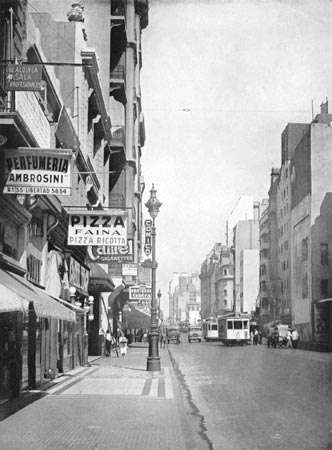Archive
Horacio Coppola
- Horacio
- Coppola
- 31-07-1906
- Buenos Aires (AR)
- 18-06-2012
- Buenos Aires (AR)
- FilmmakerPhotographer
Born in Buenos Aires, Horacio Coppola is one of the photographers who represent modern photography in Argentina.
Word Count: 17

Horacio Coppola, "Nocturno. Calle Corrientes desde Reconquista hasta Plaza de la República (centro)", in Buenos Aires 1936: Cuarto centenario de su fundación. Visión fotográfica. Municipalidad de la Ciudad de Buenos Aires, 1936 (via Wikimedia Commons). 
Horacio Coppola, "Bar Madrid sobre la Avenida de Mayo", in Buenos Aires 1936: Cuarto centenario de su fundación. Visión fotográfica. Municipalidad de la Ciudad de Buenos Aires, 1936 (via Wikimedia Commons). 
Horacio Coppola, "Plaza de la República. Fiesta de la Bandera (Centro)", in Buenos Aires 1936: Cuarto centenario de su fundación. Visión fotográfica. Municipalidad de la Ciudad de Buenos Aires, 1936. 
Horacio Coppola, "Liquidación en una casa de trajes, Buenos Aires, esquina de Bartolomé Mitre y Maipú en 1936", in Buenos Aires 1936: Cuarto centenario de su fundación. Visión fotográfica. Municipalidad de la Ciudad de Buenos Aires, 1936 (via Wikimedia Commons). 
Horacio Coppola, "La Avenida Corrientes, recientemente ensanchada sobre su lado sur. Vista desde la cuadra del 1200 hacia el oeste", in Buenos Aires 1936: Cuarto centenario de su fundación. Visión fotográfica. Municipalidad de la Ciudad de Buenos Aires, 1936 (via Wikimedia Commons). Gorelik, Adrían. “Imágenes para una fundación mitológica. Apuntes sobre las fotografías de Horacio Coppola.” Punto de vista, no. 53, November 1995, pp. 20–25. Archivo Histórico de Revistas Argentinas, https://ahira.com.ar/ejemplares/53/. Accessed 20 April 2021.
Príamo, Luis. “El joven Coppola.” Horacio Coppola. Los Viajes, exh. cat. Galería Jorge Mara – La Ruche, Buenos Aires, 2009.
Word Count: 58
Coppola, Horacio. Buenos Aires 1936: Cuarto centenario de su fundación. Visión fotográfica. Municipalidad de Buenos Aires, 1936.
Coppola, Horacio. Buenos Aires 1936: Cuarto centenario de su fundación. Visión fotográfica. Municipalidad de Buenos Aires, 1937.
Word Count: 36
Buenos Aires, Argentina (1906–1932), Germany (1932–1935), Buenos Aires, Argentina (1935–2012).
Calle Hilario Ballesteros 1054, Villa Sarmiento district, Morón (often attributed to Ramos Mejía) (residence), Avenida Corrientes 3148, approximately, Almagro, Buenos Aires.
- Buenos Aires
- Laura Karp Lugo. "Horacio Coppola." METROMOD Archive, 2021, https://archive.metromod.net/viewer.p/69/2950/object/5138-7584207, last modified: 03-09-2021.
-
Gyula KosiceSculptorPoetBuenos Aires
Born in Kosice (Slovakia), the four-year-old future artist Gyula Kosice reached Buenos Aires by ship in 1928. He forged ties of friendship with Grete Stern, Horacio Coppola and other artists.
Word Count: 29
Gertrudis ChalePainterBuenos AiresGertrudis Chale was an Austrian painter based in Buenos Aires, where she achieved integration into the local art scene and spent years travelling throughout the region.
Word Count: 26
Grete SternPhotographerBuenos AiresGrete Stern is one of the photographers that represent modern photography in Argentina. Her house in Ramos Mejía was a meeting place for local and foreign artists and intellectuals.
Word Count: 30
Luis SeoanePainterMuralistIllustratorLawyerBuenos AiresLuis Seoane is an artist mainly known for his murals, paintings and illustrations. He spent his childhood and youth in Galicia, before settling in Buenos Aires in 1936.
Word Count: 27
María Elena WalshPoetSong-writerSingerBuenos AiresMaría Elena Walsh was an Argentine singer-songwriter, musician, writer, composer and poet who left her mark on several generations of Argentines through songs such as Manuelita and La Reina Batata.
Word Count: 31
Arte Madí PhotomontagePhotomontageBuenos AiresConceived in 1947 as the logo of the Arte Madí group, this photomontage was devised by two masters of the Argentinian avant-garde, Gyula Kosice and Grete Stern.
Word Count: 26
Buenos Aires 1936. Visión fotográficaPhotobookBuenos AiresFor the commemoration of the 400th anniversary of the foundation of Buenos Aires, photographer Horacio Coppola was commissioned by its municipality to portray the city.
Word Count: 25
Victoria OcampoWriterBuenos AiresVictoria Ocampo was one of the most influential intellectuals in Argentina. Her home became a key meeting place for exiles and locals and deeply impacted the artistic milieu.
Word Count: 28
Ellen AuerbachPhotographerNew YorkWhen she arrived in New York in 1937, the German-born photographer Ellen Auerbach (formerly Rosenberg) had already passed through exile stations in Palestine and Great Britain.
Word Count: 25
Asociación Amigos del ArteAssociationBuenos AiresFounded in 1924, the Asociación Amigos del Arte (Friends of the Arts Association) was a central organisation within the artistic milieu in Buenos Aires and became a relevant space of exhibition.
Word Count: 31
SurMagazineBuenos AiresIn 1931, Victoria Ocampo founded Sur, a literary magazine and publishing house aligned with the anti-fascist cause, which was to become a major hub for intellectual exchanges in Buenos Aires.
Word Count: 29